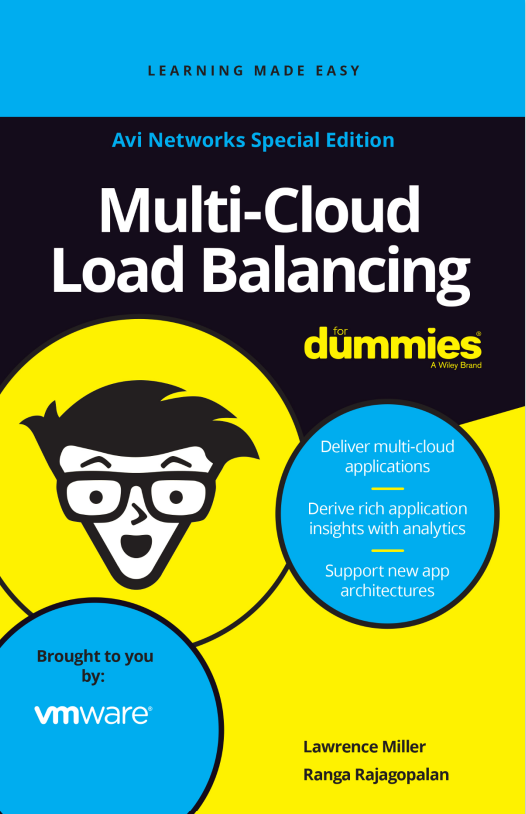What is multi-cloud?
With so many cloud offerings out there, it can pay to take a pick-and-mix approach


One of the most noticeable technology trends over the last few years has been the adoption of cloud services, as businesses look to transform themselves digitally and keep up with the competition.
RELATED RESOURCE

Multi-cloud load balancing for dummies
Deliver multi-cloud applications and support new app architectures
Offering a vast number of benefits - from enhanced security, reduced costs, increased productivity, and greater scalability and innovation - the cloud helped organisations stay operational during the disruptions of the pandemic, and continues to appeal to companies that want to proof themselves from any future uncertainties.
Cloud capabilities allowed businesses to support their remote workforces with their storage and collaboration tools, removing geographical barriers and empowering staff to make decisions with the data available to them. This not only boosted employee morale, having autonomy and trust from their company, but it also enhanced their customer service offering, which in turn increased profitability.
With the options available, IT professionals have the ability to pick and choose the cloud elements that are most valuable to them, aligning with specific business needs. A multi-cloud approach can offer this, so companies don’t need to depend on a singular cloud provider, but instead choose from several vendors in order to get the best solution from each.
It also means being able to save costs, as organisations can select certain services based on who is offering the lowest price at the time.
The multi-cloud concept
As the name would suggest, at its most base level, multi-cloud refers to the practice of using multiple cloud services at the same time.
This shouldn't be confused with hybrid cloud, which involves mixing public and private cloud platforms to extract the benefits of both rather than opting for one over the other. Rather, multi-cloud combines multiple public and private cloud environments, each chosen with a specific workload or set of workloads in mind.
Sign up today and you will receive a free copy of our Future Focus 2025 report - the leading guidance on AI, cybersecurity and other IT challenges as per 700+ senior executives
For example, an organisation might use a private cloud to house its most sensitive data or information that needs to stay within specific national borders as per data regulations such as GDPR. At the same time it might use Salesforce's cloud-based customer relationship management services to handle its CRM functions, while Google's G Suite or Microsoft's Office 365 provide the productivity tools for an organisation that wishes to facilitate easy document sharing and collaboration for its employees.
The same company's website could be hosted on Amazon Web Services or Microsoft Azure public cloud infrastructure, with the scope to scale compute resources depending on demand. App development and testing, meanwhile, could be carried out on the IBM Cloud, supporting DevOps teams as they create cloud-based apps.
Given many businesses are now data rich, a private deployment of the SAP Cloud Platform, which includes the HANA in-memory relational database management system, could be used to not only process that data in a secure cloud-based environment, but also run analytics on it to gain useful business insights.
Finally, if the organisation uses a lot of contractors, then cloud-based virtual machines from the likes of VMWare could be used to spin up virtual desktops and apps for them to use, without needing to provide dedicated hardware-linked desktops and workplaces.
Having a multi-cloud infrastructure is arguably a means by which to drive digital transformation within an organisation without running the risk of opting for a few services that do not quite fit the demands of an enterprise.
What are the benefits of multi-cloud?
The most prominent benefit of multi-cloud is flexibility. Given the myriad cloud services out in the market, with each one offering all manner of different services and features, it can be difficult just to select one or two and be sure you have the best suite of digital services and cloud-based infrastructure in place.
As such, being able to essentially mix and match different cloud services can lead to a more comprehensive cloud strategy than if just a couple of "comprehensive" products were chosen. The multi-cloud approach also has the flexibility to allow for change in some areas without needing to overhaul or migrate entire swathes of infrastructure or data from one core cloud service to another.
A multi-cloud approach also avoids vendor lock-in, whereby an organisation is beholden to using a limited number of cloud services due to the function and technology they provide and thus at the mercy of the provider ramping up its prices or forcing unpalatable service agreements on its existing customers.
What are the disadvantages of multi-cloud?
With flexibility comes complexity, and that is the most prominent disadvantage of a multi-cloud infrastructure.
While managing cloud services and infrastructure has become more streamlined in recent years, having several to look after at the same time is never going to be a simple task.
Managing a complex portfolio of cloud services can end up putting increased strain on an IT team, rather than freeing them up to pursue one of the great promises of the cloud: Pursuing tasks and technologies that provide a more direct benefit to the business.
There are services that can provide management systems to oversee and control multiple cloud services at once, delivering a so-called "single pane of glass" from which all cloud services in an organisation's operation can be managed from. Of course, this is an additional cost that will need to be considered when deciding whether to take a multi-cloud approach to IT.
Indeed, cost in general is another major disadvantage of multi-cloud: Having multiple specialised cloud services and systems rather than a couple of heavily-featured cloud platforms, could be an expensive undertaking. As such, there needs to be a balance of cost per service and the advantages specialised cloud systems can deliver.
Managed service providers can help here, bundling multiple cloud services into a single package and thereby keeping overall costs manageable, but again an IT team and other business decision-makers will need to measure up the costs versus benefits.
Regardless of the advantages and disadvantages of a multi-cloud approach, more companies appear to be taking their IT strategies down that route, with IBM noting that 85% of organisations now use a multi-cloud IT model.
As such, if your business is undertaking a digital transformation push, then the multi-cloud approach is worth giving some careful consideration.
Roland is a passionate newshound whose journalism training initially involved a broadcast specialism, but he’s since found his home in breaking news stories online and in print.
He held a freelance news editor position at ITPro for a number of years after his lengthy stint writing news, analysis, features, and columns for The Inquirer, V3, and Computing. He was also the news editor at Silicon UK before joining Tom’s Guide in April 2020 where he started as the UK Editor and now assumes the role of Managing Editor of News.
Roland’s career has seen him develop expertise in both consumer and business technology, and during his freelance days, he dabbled in the world of automotive and gaming journalism, too.
-
 How the UK public sector could benefit from strategic channel partnerships
How the UK public sector could benefit from strategic channel partnershipsIndustry Insights Is the channel the answer to the growing cost vs budget problem facing the public sector?
-
 Microsoft wants to replace C and C++ with Rust by 2030
Microsoft wants to replace C and C++ with Rust by 2030News Windows won’t be rewritten in Rust using AI, according to a senior Microsoft engineer, but the company still has bold plans for embracing the popular programming language
-
 Global IT spending set to hit a 30-year high by end of 2025
Global IT spending set to hit a 30-year high by end of 2025News Spending on hardware, software and IT services is growing faster than it has since 1996
-
 AI tools are a game changer for enterprise productivity, but reliability issues are causing major headaches – ‘everyone’s using AI, but very few know how to keep it from falling over’
AI tools are a game changer for enterprise productivity, but reliability issues are causing major headaches – ‘everyone’s using AI, but very few know how to keep it from falling over’News Enterprises are flocking to AI tools, but very few lack the appropriate infrastructure to drive adoption at scale
-
 Pegasystems teams up with AWS to supercharge IT modernization
Pegasystems teams up with AWS to supercharge IT modernizationNews The duo aim to create deeper ties between the Blueprint, Bedrock, and Transform services
-
 Better together
Better togetherWhitepaper Achieve more with Windows 11 and Surface
-
 Transforming the enterprise
Transforming the enterpriseWhitepaper With Intel and CDW
-
 The top trends in money remittance
The top trends in money remittanceWhitepaper Tackling the key issues shaping the money remittance industry
-
 Inside the Make-A-Wish Foundation ‘lift and shift’ cloud transformation
Inside the Make-A-Wish Foundation ‘lift and shift’ cloud transformationCase Study The charity wrestled with budgetary challenges to overhaul its legacy IT by tapping into Microsoft Azure
-
 How Kantar revamped its IT infrastructure after being sold off
How Kantar revamped its IT infrastructure after being sold offCase Study Being acquired by a private equity firm meant Kantar couldn’t rely on its parent company’s infrastructure, and was forced to confront its technical shortcomings
